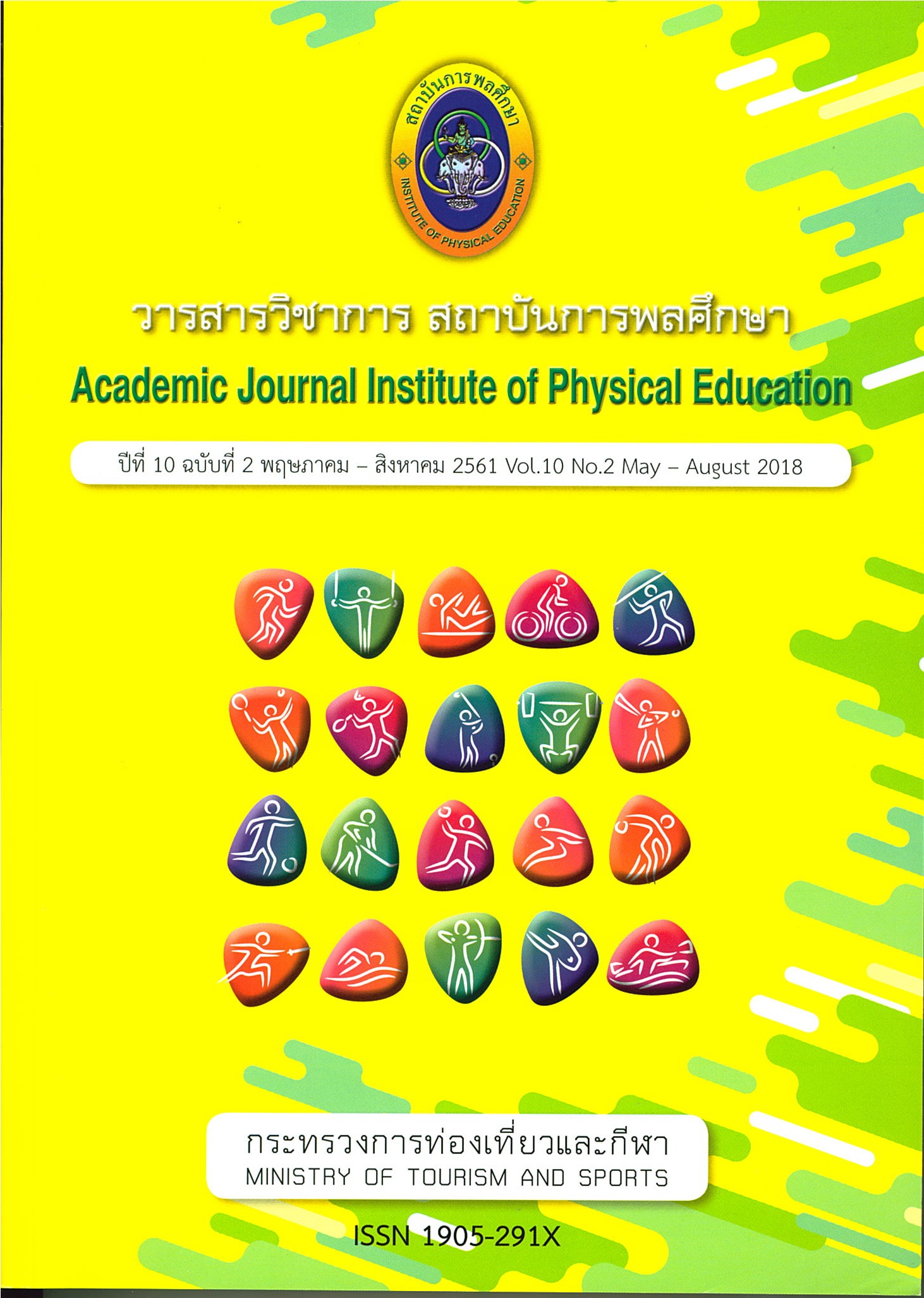Perception of Motivation in Aerobic Dance Exercise Participants
Main Article Content
Abstract
The purpose of this study was to determine the perception of motivation in aerobic dance exercise participants. Subjects were 50 females, aged 33 to 55 years, who have participated inaerobic dance exercise 5 to6 days per week. Data were collected by critical incidence notation, observation and interviewing, then analyzed by constant comparison and triangulation methodology. It was perceived that intrinsic motivations were needs to be healthy, to have fun and happiness in exercise and to be confident and proud of ability to follow the rhythms, while extrinsic motivations were social connections with more friends, convenient and economic exercise, suitable location and good environment, whereas demoting reasons were injury, lack of aerobic dance exercise knowledge and unsuitable environment.
Article Details
The published article is a copyright of the Academic Journal of Thailand National Sports University. The passage appeared in each article in this academic journal is a perspective of each author which is not related to the journal. Each author is required to be responsible for all components of his/her own article. If there are any mistakes, each author must be responsible for those mistakes on his/her own.
References
ชงชัยบุสสี. (2547).แรงจูงใจในการเดินและวิ่งเหยาะของผู้สูงอายุในจังหวัดสระบุรี. ปริญญานิพนธ์การศึกษามหาบัณฑิต. กรุงเทพมหานคร: บัณฑิตวิทยาลัย มหาวิทยาลัยศรีนครินทรวิโรฒ.
ชุติมารอดประทับ. (2550).แรงจูงใจในการเลือกกิจกรรมการออกกำลังกายของประชาชนในสวนสาธารณะ จังหวัดชลบุรี ปี พ.ศ. 2549. ปริญญานิพนธ์การศึกษามหาบัณฑิต (พลศึกษา). กรุงเทพมหานคร: บัณฑิตวิทยาลัย มหาวิทยาลัยศรีนครินทรวิโรฒ.
ดำรง กิจกุศล. (2544). คู่มือออกกำลังกาย. กรุงเทพมหานคร: สำนักพิมพ์หมอชาวบ้าน.
ธีรวัฒน์กุลทนันทน์. (2553). คู่มือป้องกัน-ฟื้นสมรรถนะแด่ผู้ที่รักการวิ่ง บาดเจ็บจากการวิ่ง. สืบค้นจาก thairunning.com online.
ปรียา กุลละวณิชย์. (2560). หมอชาวบ้าน. สืบค้นจาก thairunning.com online.
พงษ์พันธ์ พงษ์โสภา. (2542). จิตวิทยาการศึกษา. ปริญญานิพนธ์ พัฒนาศึกษา วิทยาศาสตร์มหาบัณฑิต (พลศึกษา). กรุงเทพมหานคร: บัณฑิตวิทยาลัย มหาวิทยาลัยเกษตรศาสตร์ถ่ายเอกสาร.
พีระพงษ์ บุญศิริ. (2536). จิตวิทยาการกีฬา. กรุงเทพมหานคร: โอเดียนสโตร์.
สนธยา สีละมาด. (2547). หลักการฝึกกีฬาสำหรับผู้ฝึกสอนกีฬา.กรุงเทพมหานคร: จุฬาลงกรณ์มหาวิทยาลัย.
สนธยา สีละมาด. (2557). กิจกรรมทางกาย. กรุงเทพมหานคร: จุฬาลงกรณ์มหาวิทยาลัย.
สมาพร ทองมี. (2545). แรงจูงใจต่อการออกกำลังกายของพนักงานบริษัทกาดสวนแก้ว จำกัด. การค้นคว้าแบบอิสระ สาธารณสุขศาสตรมหาบัณทิต. เชียงใหม่: บัณฑิตวิทยาลัย มหาวิทยาลัยเชียงใหม่.
สาลี่ สุภาภรณ์. (2550). วิจัยเชิงคุณภาพทางพลศึกษาและกีฬา. กรุงเทพมหานคร: ห้างหุ้นส่วนจำกัด สามลดา.
สืบสาย บุญวีรบุตร. (2541). จิตวิทยาการกีฬา. ชลบุรี: ชลบุรีการพิมพ์.
อภิวันท์โอนสูงเนิน. (2557). การศึกษาเหตุผลในการออกกำลังกายด้วยการเต้นแอโรบิก ผลที่เกิด และความต้องการของประชาชนที่ออกกำลังกายด้วยการเต้นแอโรบิกในจังหวัดสุโขทัย พ.ศ. 2556. สุโขทัย: สถาบันการพลศึกษา วิทยาเขตสุโขทัย.
Kolt, G. S., Driver, R. P., & Giles, L. C. (2004). Why older Australians participate in exercise and sport. J Aging Phys Act, 12(2), 185-198.
Nigg, B. M., Khan, A., Fisher, V., & Stefanyshyn, D. (1998). Effect of shoe insert construction on foot and leg movement. Med Sci Sports Exerc, 30(4), 550-555.


